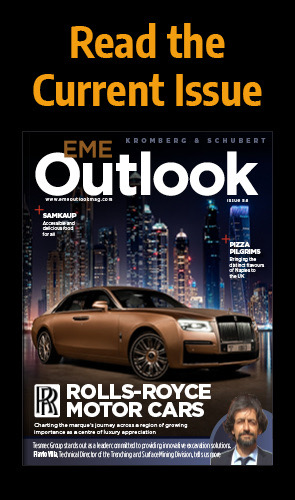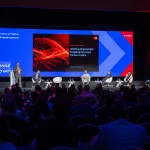For most enterprises, and certainly most of Oracle’s customers, a drive to simplify Information Technology (IT) is becoming of ever-increasing importance. Oracle has become one of the largest technology companies in the world on the strength of its extensive portfolio of software and hardware products to facilitate this simplification. In this special feature, Europe Outlook interviews senior managers in Oracle EMEA including the Vice Presidents of Product Strategy, Product Development and Security & Identity Solutions. Plus, we take an in-depth look inside the Oracle brand, showcasing how the company sees the importance of cloud, social, mobile and critical applications in changing the way we do business today.
Q&A WITH RICHARD BEATTIE, EMEA APPLICATIONS SENIOR DIRECTOR, MARKETING CLOUD & SOCIAL CLOUD
What’s Oracles View on how Social Media is changing enterprise business?
Richard Beattie (RB): Here’s a lesson CMOs and CIOs should take to heart: yesterday’s enterprise social strategy won’t work today, and today’s won’t work tomorrow. Why? Well, let’s examine a few core principles of the social environment.
Social is global. It’s important to realise that at least 75% of the traffic on Facebook and Twitter comes from outside the United States. To borrow a phrase, the world is flat. It’s a global marketplace, thanks in part to social networking, and brands are launching globally. No matter what type it is or where it’s located, a company today needs to have a presence that scales globally.
That’s where social marketing can play an important role. Social takes marketing global – but only if the capability is built in. That capability includes, for example, support for multiple languages, including idioms and slang, and for multiple social platforms, such as Renren, the Chinese version of Facebook.
Social is ubiquitous. At work, employees want to use the same tools, and have the same online experiences they have in their personal lives: content sharing, newsfeeds, messaging, etc. Similarly, customers want to interact with their vendors the same way they interact with their friends. Today’s consumers don’t buy products; they invest in brands. And they don’t want to interact with a department; they want to do business with a peer.
In terms of enterprise strategy, social entered by way of the marketing department but is rapidly extending its reach across organisations’ various divisions. For example, human resource managers have realised that they can use social capability to help retain their best employees as well as to seek out the best new prospects.
Social is real-time. Twitter upped the ante in terms of the time element involved in social networking. In the Twitter-sphere, conversations begin, explode and trail off in what seems like the blink of an eye. Unfortunately, the damage to a company’s reputation incurred from a negative Twitter blast can last a very long time.
So, I ask organisations everywhere: How well have you kept up? If you created your enterprise social strategy more than a year ago, chances are you weren’t factoring in at least some of these trends and capabilities. For instance, is your strategy truly global? Does it extend internally across your organisation? Is Twitter a part of that strategy? And is the lesson of Twitter – listening closely and reacting in real time – a critical element?
How is social affecting modern marketing?
(RB): If you’re a marketing leader, you often need to think like an artist. Using the right tone and pitch in your Facebook messages; crafting the storyboard for your 25-second YouTube video; evoking an emotional response with one simple tweet–these things require intuition, a sense of taste, and the courage to act without precedent.
At the same time, marketing executives must understand hard science. If you’re looking to derive customer insights from social data and big data, you need tools that will allow you to be uncompromisingly objective. That’s why marketing technologies are increasingly appropriating methods from behavioural economics, psychology, and statistics–and eliminating unnecessary guesswork in the process.
Here are some of the social marketing related topics and questions that modern marketing leaders need to tackle:
The Science
– It’s vital that marketers understand the technology of social networks, those that are here and those yet to come. What are their functions? What value proposition do they offer marketing?
– Marketers must think about ways to integrate those networks into one manageable platform for efficient publishing and facilitating a comprehensive picture of your social analytics.
– With organic reach dropping and the importance of paid social rising, how can companies work with paid social media partners to quickly leverage top performing content and extend their reach and engagement?
– Listening to the customer has become every bit as important as pushing marketing messages. Your social listening tool should alert you to the current hot topic in your space, what the public is saying about you, where the competition is messing up so you can offer better solutions, how people are responding to your campaigns, and the overall sentiment for your brand.
– An enterprise work flow system means tasks can be assigned and managed and customer communications can be routed to the right person for the fastest response and resolution.
All these tools point to an ideal: the social-enabled enterprise, in which social weaves not only through marketing functions, but connects to other enterprise systems such as CRM, sales, HR, and fulfilment for the most powerful use of big data imaginable.
The Art
Tech is far from the answer to every marketing challenge. Creativity is not only still vital – it’s even more door- die as content quality separates winners from losers.
– As a marketing leader, what skills should you look for in identifying creative talent?
– Brands now have to be “liked,” so you can’t realistically proceed with no brand voice and personality. People don’t connect with entities, they connect with humans. There’s an intuitive art to striking a chord with people and making them want to associate with you.
– You often hear about how effective it is to surprise and delight customers. Yes, tech can show what your audience tends to like, but creating something that truly catches them off guard and sweeps them off their feet is an art.
Social is but one part of the modern marketing ecosystem. But perhaps more than any other component, as a result of being in the trenches of day-to-day brand/ customer relationship building and nurturing, social is where you’re likely to find the most even mix of art and science.

















